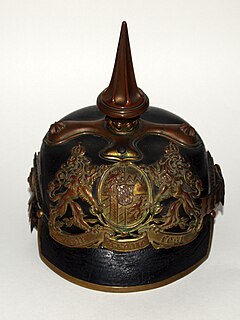 W
WTropentarn, formerly known as Wüstentarn, is a camouflage pattern used by the Bundeswehr in arid and semi arid regions. It is the desert variant of the Flecktarn 5-color temperate climate camouflage print of the Bundeswehr.
 W
WCorps colours, or Troop-function colours, were worn by the National People's Army of the German Democratic Republic from 1956 to 1990.
 W
WCorps colours, or troop-function colours were traditionally worn in the German armed forces, the Wehrmacht, from 1935 until 1945, to distinguish between several branches, special services, corps, rank groups and appointments of the ministerial area, general staff, Oberkommando der Wehrmacht, down to the military branches Heer, Luftwaffe and Kriegsmarine. The corps colour was part of the uniform piping, gorget patches, shoulder straps, arabesque and lampasse ornaments of general and flag officers. It was also part of the heraldic flags, colours, standards and guidons.
 W
WThe cuff title is a form of commemorative or affiliation insignia placed on the sleeve, near the cuff, of German military and paramilitary uniforms. The tradition can be traced back to the foundation of the "Gibraltar" band, which was donated in 1783 by King George III for regiments of the Electorate of Hanover. Cuff title are most commonly seen in the Second World War but also seen postwar.
 W
WThe Ranks of the National People's Army were the military insignia used by the National People's Army, the army of the German Democratic Republic, from 1956 to 1990.
 W
WFlecktarn is a family of 3-, 4-, 5- or 6-color disruptive camouflage patterns, the most common being the five-color pattern, consisting of dark green, light green, black, red brown and green brown or tan depending on the manufacturer. The original German 5-color pattern was designed for use in European temperate woodland terrain. A 3-color variation called Tropentarn is intended for arid and desert conditions; the German Bundeswehr wore it in Afghanistan.
 W
WLeibermuster is a German military camouflage pattern first used in 1945. It was the last of a family of German World War II camouflage patterns. The pattern was issued on a very limited basis to combat units before the war ended. It consists of bold irregular areas of black printed over brown and green on a pale background.
 W
WThe Pickelhaube, also Pickelhelm, is a spiked helmet that was worn in the 19th and 20th centuries by Prussian and German military, firefighters and police. Although it is typically associated with the Prussian Army, which adopted it in 1842–43, the helmet was widely imitated by other armies during that period. It is still worn today as part of ceremonial wear in the militaries of certain countries, such as Sweden, Chile, and Colombia.
 W
WSplittertarnmuster, Splittertarn or Splittermuster (splinter-pattern) is a four-colour military camouflage pattern developed by Germany in the late 1920s, first issued to the Reichswehr in 1931.
 W
WThe SSK 90 helmet was a short-lived World War II Luftwaffe helmet. Manufactured by Siemens, the helmet consisted of an inner core of interlocking steel plates, a goatskin exterior, and an underside with foam rubber padding and a cloth lining; a prominent protrusion at the front helped to put on and take off the helmet quickly, and served as extra padding in case of a crash. The helmet had cutouts for earphones, and was designed to be worn over a cloth flight helmet outfitted with radio gear.
 W
WThe Stahlhelm is a specific type of German military headgear made of steel, which is primarily intended to provide protection against shrapnel and fragments of grenades. The term Stahlhelm refers both to a generic steel helmet and more specifically to the distinctive German military design.
 W
WThe Kriegsmarine was the navy of Nazi Germany prior to and during World War II. Kriegsmarine uniform design followed that of the preexisting Reichsmarine, itself based on that of the First World War Kaiserliche Marine. Kriegsmarine styles of uniform and insignia had many features in common with those of other European navies, all derived from the British Royal Navy of the 19th century, such as officers' frock coats, sleeve braid, and the "sailor suit" uniform for enlisted personnel and petty officers.
 W
WThe uniforms and insignia of the Schutzstaffel were paramilitary ranks and uniforms used by the Schutzstaffel (SS) between 1925 and 1945 to differentiate that organization from the regular German armed forces, the German state, and the Nazi Party.
 W
WThe following is a general overview of the Heer main uniforms, used by the German army prior to and during World War II.
 W
WThe Luftwaffe was the air force of Nazi Germany prior to and during World War II. Luftwaffe styles of uniform and rank insignia had many unique features between 1935 and 1945. By Hitler's decision on February 26, 1935, the Luftwaffe was to be officially the third branch of the Wehrmacht as of March 1, 1935. The new Luftwaffe was faced with the problem of uniforms, as they wanted a uniform distinct from those of the other two branches of the Wehrmacht and also wanted a clear differentiation in dress of military and civilian flyers.
 W
WIn the German military, Waffenfarbe is a visual method that the armed forces use to distinguish between different corps or troop functions in its armed services. The Waffenfarbe itself can take the form of the color of the collar patch, of the piping (embellishment) around the shoulder boards or shoulder marks, or—for enlisted ranks—of the piping around the collar and the garrison cap (Schiffchen).
 W
WWaffenrock was originally a medieval German term for an outer garment, worn by knights over their armor.